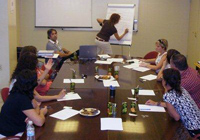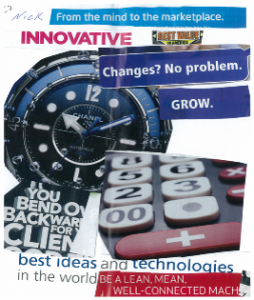Projective Techniques
Why use projective techniques? Projective techniques are important in breaking through the wall of rationalizations consumers use on a daily basis to justify the purchase or likes/dislikes of products or brands. For example, when asking a direct question to focus group participants, participants will respond with an answer that they believe is reasonable in the eyes of their peers. However, the response may or may not be true.
 With projective techniques, we go beyond simple question and answers by asking participants to respond to scenarios or create characterizations that capture deeper feelings towards a product or brand. These scenarios and characterizations force participants to fill in gaps in their perceptions of a given product or brand with the emotional benefits they receive from using or purchasing the product or brand. And it is these emotional benefits brand managers need most to understand for they unlock true motives behind purchase decisions. These techniques allow participants to project their emotions and associations with a given product or brand, which in turn shows us how those feelings form the basis for decisions on what a brand means, the quality of a product, or other aspects related to the marketing mix.
With projective techniques, we go beyond simple question and answers by asking participants to respond to scenarios or create characterizations that capture deeper feelings towards a product or brand. These scenarios and characterizations force participants to fill in gaps in their perceptions of a given product or brand with the emotional benefits they receive from using or purchasing the product or brand. And it is these emotional benefits brand managers need most to understand for they unlock true motives behind purchase decisions. These techniques allow participants to project their emotions and associations with a given product or brand, which in turn shows us how those feelings form the basis for decisions on what a brand means, the quality of a product, or other aspects related to the marketing mix.
Dial Testing Using Perception Analyzers
This technique permits real time analysis of participant feelings towards a given stimulus. The feelings are captured using a numerical dial and may be segmented by age, income, gender, etc. The stimulus may be played back during a focus group with the numerical data displayed as graphs, and this data then becomes a source for further probing on likes/dislikes and strengths/weaknesses of the stimulus.
Mindmapping
This technique helps generate ideas and makes clear the relationship of these ideas between and within groups. Mindmapping also derives concepts directly from participants that can be used to communicate product benefits with a broader market. The exercise can be done at the individual participant level or at the group level. It also facilitates brainstorming and idea generation.
Choice Ordering
This technique is used to force participants to evaluate their input by asking them to rank or order certain factors or attributes associated with a brand or service. This exercise is commonly combined with mindmapping, especially when the object of the mindmap is to establish preferences or desires.
 Collage
Collage
This technique allows participants to compose visual representations of their thoughts or feelings. Participants move beyond the bounds of language to more accurately and completely communicate their opinions in pictures and words.
Brand and User Imagery
This technique permits one to evaluate disconnects between the perceptions of the brand (or activity) and perceptions of users of the brand (or participants in the activity). Participants are asked to convey their perception of the brand/activity. Afterwards, participants are asked to explain who might use the brand or participate in the activity. Discrepancies can be further probed to provide deeper insights.
Timescape
This technique permits participants to explain their view of the future. Often this involves setting the stage with some scenario, like “pretend you are on a spaceship and you are gone for ten years. When you return to Earth, what changes have you noticed in terms of how people (do their work, communicate, travel, etc.)?” Participant response is analyzed to see how well the present solution satisfies potential future requirements.
Word Association
 Here words describing brands or companies are tossed out and participants are asked to indicate their “top-of-the-mind” feelings,
Here words describing brands or companies are tossed out and participants are asked to indicate their “top-of-the-mind” feelings,
thoughts, or opinions. Often participants are probed for positive and negative outcomes. Each word associated with the brand can be further evaluated through various psychodrama or role playing.
Tradeoff
Participants are given shapes to fit within a space on a piece of paper. Each shape represents a particular product attribute. However, participants cannot fit all shapes into the space; therefore, to complete their box, participants must tradeoff certain attributes for others. This prioritization can then be evaluated at the group level and probed for clarification. A variation of this is a card sort where participants must sort attributes into categories (must have, nice to have, not important, for example).
 Projective Drawing
Projective Drawing
Participants are asked to draw potential consumers for products. They are also asked to provide basic demographics and characteristics of these potential consumers. Drawings are then discussed to explore differences in perceptions.
Family of Brands
Participants are asked to describe a brand as a family member in an extended family or an animal in a zoo or as an automobile. The set of possible choices may be limited for purposes of consensus. Helps to understand values or feelings which a person cannot readily express.
Laddering
Laddering is an in-depth interview technique. Participants are asked to define the attributes of a product and then describe the rational benefits of that product. Participants are then asked to explain why that benefit is of importance to them. The chain that is developed links product attributes to psycho-social or emotional benefits held by consumers. The chain can be an upward ladder to an emotional benefit, or, can be reversed as a downward ladder to find out the disadvantages of a competitive brand in terms of its rational benefits.
Guided Imagery
Participants are asked to imagine a brand by taking a journey in a dream-like state. The details of this experience are then evaluated to provide clues as to what participants feel about a brand or product.
Applied principal, Donald Phipps, uses projective techniques in qualitative research. To see his background and experience click on the link below.
